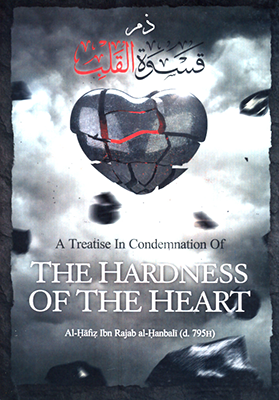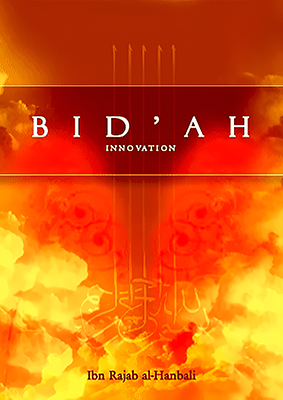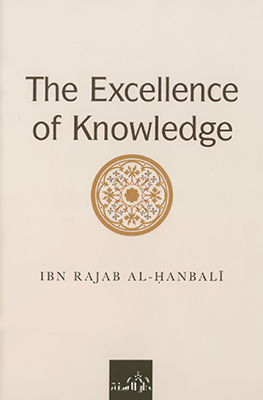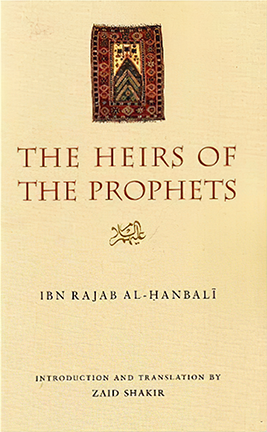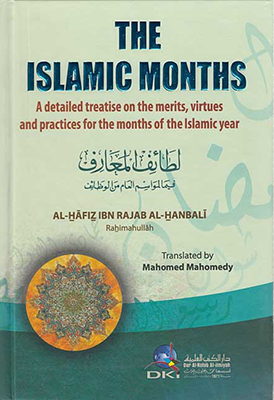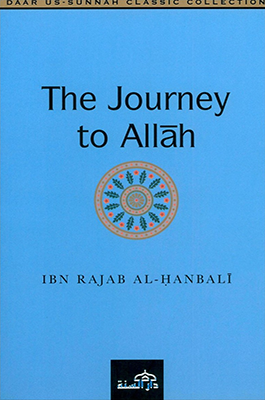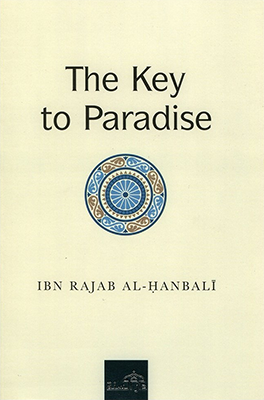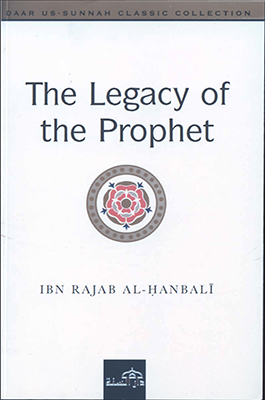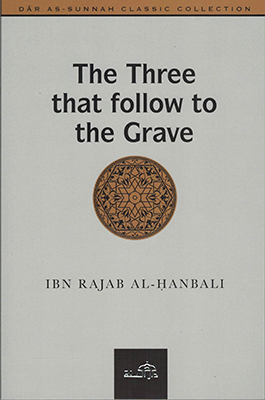He was Abul-Faraj Zayn-ud-Deen ‘Abdur-Rahman bin Ahmad bin ‘Abdir-Rahman bin al-Hasan bin Muhammad bin Abil-Barakat Mas’ud as-Salami al-Baghdadi ad-Dimashqi al-Hanbali, better known as al-Hafidh Ibn Rajab al-Hanbali.
His scholarly title was Zayn-ud-Deen or “Adornment of the Religion” and he went by the nickname of Ibn Rajab – an ascription to his grandfather, ‘Abdur-Rahman, who was known as Rajab since he was born in that month. He ascribed himself to Baghdad because that was where he was born; to Dimashq (Damascus) because that was were he settled; and to Hanbal, because that the scholar who jurisprudence (Fiqh) he adhered to. He was the great Imam, the Hafidh, the Critic, the Shaykh of the Hanbali jurists in his time, reviver of the Sunnah, defender of Islam and devout worshipper of Allah.
His Birth and Upbringing
He was born in Baghdad in 736H according to the most correct view. His birth took place nearly eighty years after the fall of Baghdad, the metropolis of knowledge at that time, at the hands of the Mongols. And the effects of the devastation were still present even at the time of Ibn Rajab’s birth. Al-Hafidh Ibn Rajab was raised in a pious household that was firmly rooted in knowledge, nobility and righteousness. His grandfather, ‘Abdur-Rahman bin al-Hasan, was one of the scholars of Baghdad who had a circle in which he would teach students Hadeeth using an ancient method for memorization. Ibn Rajab would attend these lessons of his grandfather on several occasions even though he was just 4-5 years old. As for his father, he was also a scholar and a Muhaddith, well-known for his knowledge and virtue. He was born in 706H and grew up in Baghdad where he studied under its scholars and teachers. He traveled to Damascus with his children in 744H in order to learn from its scholars. He did the same by traveling afterward to the Hijaz area and then to Jerusalem. After this, he settled down in Damascus to teach.
His Travels in Search of Knowledge
His father played the greatest role in directing his son towards beneficial knowledge, especially that of Hadeeth. This was since he always strove to place his son in an environment where he could hear Hadeeth from trustworthy people who were known throughout the Muslim lands for their narrations. In 744H, his father took him with him to Damascus to learn from its scholars. At that time, Damascus was a center of learning that students would flock to in order to increase their knowledge and progress in their studies. There, Ibn Rajab heard from scholars the likes of Muhammad bin Isma’eel al-Khabbaz and Ibraheem bin Dawud al-’Attar. Then Ibn Rajab and his father traveled to Egypt where they learned from ‘Izz-ud-Deen bin Jama’ah (d.767H). Ibn Rajab also studied under Sadr-ud-Deen al-Maydumee (d.754H) and Ibn al-Muluk (d.756H). After this in 748H, they returned to Baghdad and heard from other scholars. They then traveled to Jerusalem where Ibn Rajab learned from al-Hafidh Al-’Ala’i (d.761H). In 749H, they traveled to Makkah where they performed Hajj (pilgrimage). While in Makkah, Ibn Rajab studied under al-Fakhr ‘Uthman bin Yusuf. Then he moved on to Madinah and heard from its Hafidh and historian, ‘Afif-ud-Deen al-Khazraji (d.765H). After this, he returned to Damascus and devoted himself to studentship under the great scholar, Ibn Qayyim al-Jawziyyah, studying closely with him until his death in 751H. As mentioned before, when his father went back to Damascus, he settled down to teach and gave lessons. So Ibn Rajab would also attend these lessons.
His Teachers
It is clear from the above that Ibn Rajab learned and took knowledge from the greatest scholars of the Ummah at his time. In Damascus, he studied under Ibn Qayyim al-Jawziyyah, Zayn-ud-Deen al-’Iraqi, Ibn an-Naqeeb, Muhammad al-Khabbaz, Dawud at-’Atar, Ibn Qadi al-Jabal and Ahmad bin ‘Abdil-Hadee al-Hanbali. In Makkah, he heard from al-Hafidh Al-’Ala’i. And in Egypt, he heard from Sadr-ud-Deen Abul-Fath al-Maydumee and Nasir-ud-Deen bin al-Muluk. Those who have recorded Imam Ibn Rajab’s biography have counted his teachers to a number close to forty. This includes of course his father, Shihab-ud-Deen Abul-’Abbas Ahmad bin ‘Abdir-Rahman, who was his first and most influential teacher.
His Role in Teaching and His Educational Positions
After returning to Damascus, Imam Ibn Rajab continued to seek knowledge while his father began to hold circles for Hadeeth memorization. This was up until 774H when his father passed away. At this point, Ibn Rajab concluded his studying under teachers and his attending of lessons and devoted himself to researching issues, writing books and spreading knowledge. He was given a teaching position in the Hanbali School which he held until 791H. He was then in charge of Tuesday study circle held at the Grand Mosque of Bani Umayyah. This was an exclusive position which only the major scholars of the Hanbali Madhab would hold. He assumed this role after the death of Ibn Qadi al-Jabal who passed away in 771H. He continued to spend large amounts of time researching, writing, authoring, teaching, working in the field of knowledge and issuing legal rulings. The end result of this was the production of numerous works that continue to benefit the Muslim ummah to this very day.
His Students
After settling in Damascus and after the death of his father, Ibn Rajab began to hold lessons and study circles. Since he was an Imam in the Science of Hadeeth – in terms of reporting and investigating – people came to him from far and near in order to hear narrations from him. He had spent so much time engrossed in studying Hadeeth that he became known particularly for it. And along with this, there was no one found more proficient in it (during his lifetime) other than him. Al-Hafidh Ibn Rajab had numerous students, the most famous of whom were: The Judge ‘Ala-ud-Deen Abul-Hasan, Ibn al-Liham al-Ba’ali Ad-Dimashqi (d.803H), who was the closest of his students to him; Shihab-ud-Deen Abul-’Abbas Ahmad bin Abi Bakr al-Hamawi al-Hanbali, better known as Ibn ar-Risam (d.844H) whom Ibn Rajab gave ijazah (authorization); and Abu Dharr ‘Abdur-Rahman bin Muhammad al-Misri Az-Zarkashi (d.846H).
The Scholars’ Praise For Him
Ibn Qadi Shuhbah said of him in his biography, as stated in al-Jawhar-ul-Munaddad (pg.48):
He read and became proficient in the various fields of science. He engrossed himself with the issues of the (Hanbali) Madhab to the point that the mastered it. He devoted himself to the occupation of knowledge of the texts, defects and meanings of the Hadeeth. And he was unique in the books he produced.
Ibn Hajar said of him in Inba-ul-Ghamr:
He was highly proficient in the scientific disciplines of Hadeeth in terms of the names of reporters, their biographies, their paths of narrations and awareness of their meanings.
Ibraheem bin Muhammad Ibn Muflih (d.884H) said of him:
He was the Shaykh, the great scholar, the Hafidh, the one who abstained from the worldly life. He was the Shaykh of the Hanbali Madhab and he wrote many beneficial books.
The famous Muslim historian, Ibn Hijji, said:
He mastered the disciplines and became the most knowledgeable one of his time of the defects (of Hadeeth) and of researching their paths of narration.
Ibn Nasir-ud-Deen said:
The Shaykh, the Imam, the great scholar, the ascetic, the example, the blessing, the Hafidh, the trustworthy, the authority…one of the abstemious Imams and worshipping scholars.
His Piety and Characteristics
Imam Ibn Rajab was well known for his meticulous abstemiousness and piety, as he was one of those who renounced the worldly life and immersed himself in knowledge and worship. Ibn Fahd al-Makki said:
He, may Allah have mercy on him, was a pious and abstemious Imam. The hearts inclined towards him, with love and the various groups united in acceptance of him. His gatherings for reminding the people were of great benefit and used to open the hearts.
Adh-Dhahabi said about him:
Our teacher, he was one of the pious scholars, from those who renounced the worldly life and abandoned positions. This as since he would speak out the truth even if it was bitter.
His Creed
Ibn Rajab, may Allah have mercy on him, followed the methodology of the Salaf with regard to the issues of Creed and Iman. And he supported it and defended it from the false arguments of the opponents. His books are loaded with examples of that as is the case with this treatise Fadhlu ‘Ilm-is-Salaf ‘ala ‘Ilm-il-Khalaf in which he said:
The correct view is that which the pious predecessors (Salaf-as-Salih) were upon, which is leaving the verses and ahadeeth containing Allah’s Attributes as they were reported without trying to explain them (tafseer), describe their meaning (takyeef) or make comparisons to them (tamtheel).
His Madhab with regard to Fiqh (Jurisprudence)
In Fiqh, Ibn Rajab followed the madhab of the venerable Imam, Ahmad bin Hanbal. In fact, he is considered one of the major scholars of this madhab, being highly proficient and well-verses in it. What proves this is his book Al-Qawa’id-ul-Kubra fil-Furu – one of his most prominent works on the subject of Fiqh – which shows his vast knowledge on the most intricate issues of jurisprudence. Al-Hafidh Ibn Hajr said in his book ad-Durar:
He did excellent work in it.
And Ibn Qadi Shuhbah and Ibn Muflih said:
It demonstrates his comprehensive knowledge of the (Hanbali) madhab.
In Kashf-udh-Dhunun it states:
It is one of the amazing books of all time since it is highly regarded. Some claim that he took the (juristic) principles of Shaykh-ul-Islam Ibn Taymiyyah that were scattered (throughout his writings) and gathered them together, but that is not the case. Rather, he was above that. This is what was said.
Al-Hafidh Ibn Rajab was deeply attached to the works of Shaykh-ul-Islam Ibn Taymiyyah, for he would issue legal rulings according to them and would constantly reference his books. The reason for this was because he served as a student under Ibn Qayyim al-Jawziyyah, the most outstanding student of Shaykh-ul-Islam Ibn Taymiyyah, may Allah have mercy on all of them. However, in spite of this, Imam Ibn Rajab was not a blind follower or a fanatical adherent to his teacher or his teacher’s teacher. Rather, he would review, authenticate, verify and follow the evidences.
His Written Works
Al-Hafidh Ibn Rajab was considered one of the most able and famous scholars of his time at writing. This is why he left behind an extensive and rich selection of books on the various sciences of Islam including Tafseer, Hadeeth, Fiqh, History and Admonitions. Amongst his works are those that have been published and those that remain in manuscript form. He also wrote some books that cannot be found today. In total, the books of Ibn Rajab have been estimated to be around sixty works, ranging from small treatises to large volumes, most of which have been published. Some of this famous works include:
- Sharh Jami’ at-Tirmidhi, An Explanation of Sunan at-Tirmidhi: This was an amazing explanation consisting of almost twenty volumes as mentioned by al-Hafidh Ibn Hajr. It is said that is was burned in Damascus during the invasion of the Tartars in 803H led by Timurlank. So unfortunately it was lost and nothing remains from it except ten pages from the Book of Garments and the last section of it on Defects (‘Ilal), which was published in two volumes several times.
- Fath-ul-Bari bi-Sharh Saheeh-il-Bukhari, The Success of Allah in Explaining al-Bukhari’s Saheeh Collection: This is an amazing explanation of Imam al-Bukhari’s Saheeh which unfortunately was not completed. The author was only able to reach the Chapter on Funerals. Ibn Nasir-ud-Deen ad-Dimashqi referred to it as a “valuable explanation.” It has been published today and consists of seven volumes.
- Jami’-ul-’Ulum wal-Hikam fee Sharh Khamseena Hadeethan min Jawami’-il-Kalim, A Collection of Points of Knowledge and Wisdom in Explaining 50 Ahadeeth from the Prophet’s Comprehensive Statements: This is his well-known explanation of an-Nawawi’s 40 hadeeth, in which the author added 8 more ahadeeth at the end to complete the number 50, and explained each hadeeth in detailed form. This is truly one of his prized works and it has been published numerous times.
- Dhail ‘ala Tabaqat-il-Hanabilah, A Supplement to the Book Generations For the Hanbali Scholars: This was his famous biographical index which was written as a supplement (dhail) to al-Qadi Abu Ya’la’s collection, Tabaqat-il-Hanabilah. It contains biographies of the eminent Hanbali scholars from the time of Abu Ya’la’s death in 562H to Ibn Rajab’s time.
- Lata’if-ul-Ma’arif fee maa Li-Mawasim-il-’Aam min al-Wadha’if, Intricate Points of Knowledge On the Duties Throughout the Seasons of the Year: A great work published many times.
- Al-Farq Baynan-Naseehah wat-Ta’yeer, The Difference Between Advising and Condemning: A small treatise available on Al-Ibaanah.Com.
- Adh-Dhull wal-Inkisar Lil-’Azeez-il-Jabbar, Submitting and Humbling Oneself to All-Mighty, the Compeller: This book has also been published under the title Al-Khushu’ fis-Salat (Submissiveness in Prayer). One should note they are the same book.
- Sharh Hadeeth Ma Dhi’bani Ja’ian Ursilla fee Ghanam, Explanation of the Hadeeth: Two Hungry Wolves: This treatise has also been published under the title: Dham-ul-Mal wal-Jah or The Evil of Craving for Wealth & Status.
- Kashf-ul-Kurbah fee Wasfi Hali Ahlil-Ghurbah, Alleviating Grievances in Describing the Condition of the Strangers: Available on Al-Ibaanah.Com.
His Death:
Ibn Rajab traveled again to Egypt in 754H and then made Hajj in 763H. After this, he returned to Damascus where he remained until his death. He passed away on a Monday night, the fourth of Ramadan, in 795H. Some historians say it was in the month of Rajab. He died in Damascus in a land called al-Humayriyyah in a garden he used to rent. His funeral prayer was performed the next day, and he was buried in the Baab-us-Sagheer graveyard next to the grave of ‘Abdul-Wahid bin Muhammad ash-Shirazi (d.486H), one of the well-known Hanbali scholars of the past, due to his requesting that in his will. No doubt he left behind him a legacy of knowledge for all those after him to benefit from. His books continue to be studied and used as reference even today. May Allah have mercy on him and grant him a high place in Paradise.
[Taken from the book, Fadlu 'Ilm-is-Salaf 'ala 'Ilm-il-Khalaf (The Superiority of the Knowledge of the Predecessors over the knowledge of the Successors, Al-Ibaanah Book Publishing)]

